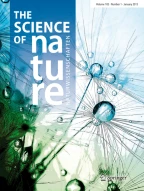Abstract
We studied the influence of the conditioning procedure on color discrimination by free-flying honeybees. We asked whether absolute and differential conditioning result in different discrimination capabilities for the same pairs of colored targets. In absolute conditioning, bees were rewarded on a single color; in differential conditioning, bees were rewarded on the same color but an alternative, non-rewarding, similar color was also visible. In both conditioning procedures, bees learned their respective task and could also discriminate the training stimulus from a novel stimulus that was perceptually different from the trained one. Discrimination between perceptually closer stimuli was possible after differential conditioning but not after absolute conditioning. Differences in attention inculcated by these training procedures may underlie the different discrimination performances of the bees.
References
Backhaus W (1991) Color opponent coding in the visual system of the honeybee. Vision Res 31:1381–1397
Backhaus W, Menzel R, Kreissl S (1987): Multidimensional scaling of color similarity in bees. Biol Cybern 56:293–304
Dyer AG, Chittka L (2004a) Fine colour discrimination requires differential conditioning in bumblebees. Naturwissenschaften, DOI: 10.1007/s00114-004-0508-x
Dyer AG, Chittka L (2004b) Biological significance of distinguishing between similar colours in spectrally variable illumination: bumblebees (Bombus terrestris) as a case study. J Comp Physiol A 190:105–114
Giurfa M (2003) Cognitive neuroethology: dissecting non-elemental learning in a honeybee brain. Curr Opin Neurobiol 13:726–735
Giurfa M, Núñez JA, Backhaus W (1994) Odour and colour information in the foraging choice behaviour of the honeybee. J Comp Physiol A 175:773–779
Giurfa M, Vorobyev M, Brandt R, Posner B, Menzel R (1997) Discrimination of coloured stimuli by honeybees: alternative use of achromatic and chromatic signals. J Comp Physiol A 180:235–244
Giurfa M, Hammer M, Stach S, Stollhoff N, Müller-Deisig N, Mizyrycki C (1999) Pattern learning by honeybees: conditioning procedure and recognition strategy. Anim Behav 57:315–324
Swinderen B van, Greenspan RJ (2003) Salience modulates 20–30 Hz brain activity in Drosophila. Nat Neurosci 6:579–586
Zentall TR, Riley DA (2000) Selective attention in animal discrimination learning. J Gen Psychol 127:45–66
Acknowledgements
Thanks are due to four anonymous referees for comments and corrections. This work was supported by the Program Ecos-Sud (Action Ecos A01 B01) and the Institut Universitaire de France.
Author information
Authors and Affiliations
Corresponding author
Rights and permissions
About this article
Cite this article
Giurfa, M. Conditioning procedure and color discrimination in the honeybee Apis mellifera . Naturwissenschaften 91, 228–231 (2004). https://doi.org/10.1007/s00114-004-0530-z
Received:
Accepted:
Published:
Issue Date:
DOI: https://doi.org/10.1007/s00114-004-0530-z
